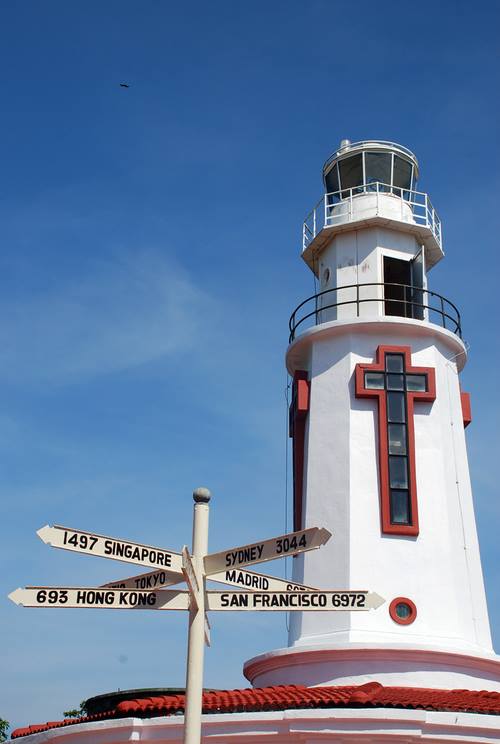 Located at the entrance of Manila Bay, Isla ng Corregidor was identified by the Spaniards as a strategic defense location when they arrived in the Philippines in the 16th century. They named the tadpole-shaped island Island of the Corrector since this was the place where all ships entering Manila Bay would stop for inspection. Since then the island fortress has been the site of many battles, from the Spanish-American War to the period of American colonialism.
Located at the entrance of Manila Bay, Isla ng Corregidor was identified by the Spaniards as a strategic defense location when they arrived in the Philippines in the 16th century. They named the tadpole-shaped island Island of the Corrector since this was the place where all ships entering Manila Bay would stop for inspection. Since then the island fortress has been the site of many battles, from the Spanish-American War to the period of American colonialism.
For those interested in taking a trip to Corregidor, you can book your tour of the island at the Sun Cruises office located at the Cultural Center of the Philippines (CCP) Complex in Pasay City. But there are other ways available to everyone interested in visiting the island of Corregidor.
Coming from the province of Bataan, tourists can take a 20-minute boat ride to the island and do a walking tour. There are also some tourist groups who organize tours for private groups. A one-day tour of Corregidor will cost around P2400 per person and this includes ferry transfers and a buffet lunch at the Corregidor Hotel.
 One should prepare for a trip to Corregidor by bringing an ample supply of bottled water. Though chips, soft drinks and other snacks are available throughout the tour of the island and food shops are available in the island’s tourist spots, it would be better to bring your own baon of food to eat during the tour.
One should prepare for a trip to Corregidor by bringing an ample supply of bottled water. Though chips, soft drinks and other snacks are available throughout the tour of the island and food shops are available in the island’s tourist spots, it would be better to bring your own baon of food to eat during the tour.
Getting to Corregidor is like taking a ride in a time machine and travelling back in time. It takes about one hour by ferry from the Sun Cruises boat terminal in Pasay City. While comfortably seated in the air conditioned ferry, they will play a documentary about Corregidor’s role during the Second World War. The trip to the island will also give you a rare view of Roxas Boulevard and the Manila skyline from Manila Bay.
Upon arrival and disembarking the Sun Cruises ferry, tourists are led to a set of open-air tranvias – the tour’s main mode of transportation – that will take them on their tour around the island. First stop is the Corregidor Hotel for a hearty lunch before the actual tour of the island begins.
Avid fans of war movies and military hardware will definitely enjoy a tour of Corregidor. Even though the island was brutally bombed in 1942, it still has some pieces of its artillery intact and in good condition.
Next is the Japanese Garden of Peace which used to be a cemetery for soldiers and civilians who died on the island. After the American forces recaptured the island from the Japanese invaders, they buried the Japanese soldiers there. The remains of the Japanese soldiers were later exhumed and brought to Japan. It is now a memorial for everyone who died in the war.
During the American colonial period in the Philippines, Corregidor was a military paradise, something similar to the other well-known American military bases in the country – Subic Naval Base and Clark Air Base. It was named Fort Mills by the Americans as part of the Manila Bay Harbor Defense Fortifications they built after acquiring the Philippines from the Spaniards.
Corregidor Island had a cinema, a school and barracks for American and Filipino soldiers residing there. Considered as the most photographed structure in the island, the Mile Long Barracks used to be a segregated home for 4,000 American and 4,000 Filipino soldiers.
 One of the fortifications in the island is considered by many as a marvel of engineering– the Malinta Tunnel. This bomb-proof storage facility took 10 years to build, from 1922 to 1932. It has a main tunnel that runs for over 800 feet with lateral tunnels branching out on each of its sides.
One of the fortifications in the island is considered by many as a marvel of engineering– the Malinta Tunnel. This bomb-proof storage facility took 10 years to build, from 1922 to 1932. It has a main tunnel that runs for over 800 feet with lateral tunnels branching out on each of its sides.
Tourist can walk inside the tunnel where important events in Corregidor’s history are brought to life through a lights and sound show. Visitors will hear President Manuel Quezon and General Douglas McArthur’s discussions on the war and also hear actual rumblings of a Japanese bombing run on the island. The lights and sound show costs P200 per person.
The next place to visit is Corregidor’s lighthouse. After being severely damaged by the war, the lighthouse was rebuilt and it now runs on solar power. Built in 1853, the lighthouse helped guide ships as they entered the mouth of Manila Bay and steered them towards the safety of the port.
 The tour of Corregidor Island ends at the museum where various war memorabilia, letters, photos and vintage models of war planes can be seen. The Pacific War Memorial has a dome which is positioned to have the sun shine exactly through the oculus every May 6 at noon, commemorating the fall of Corregidor.
The tour of Corregidor Island ends at the museum where various war memorabilia, letters, photos and vintage models of war planes can be seen. The Pacific War Memorial has a dome which is positioned to have the sun shine exactly through the oculus every May 6 at noon, commemorating the fall of Corregidor.
A tour of the island of Corregidor is highly recommended for every Filipino—as well as foreign tourists—who should always be reminded of the extreme sacrifices of the Filipino and American soldiers during World War II.








